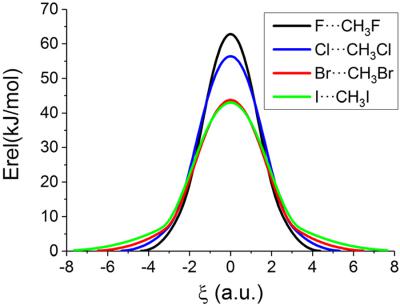当前位置:
X-MOL 学术
›
J. Comput. Chem.
›
论文详情
Our official English website, www.x-mol.net, welcomes your
feedback! (Note: you will need to create a separate account there.)
An interacting quantum atom study of model SN 2 reactions (X- ···CH3 X, X = F, Cl, Br, and I)
Journal of Computational Chemistry ( IF 3.4 ) Pub Date : 2017-11-10 , DOI: 10.1002/jcc.25098 Ibon Alkorta 1 , Joseph C R Thacker 2 , Paul L A Popelier 2
Journal of Computational Chemistry ( IF 3.4 ) Pub Date : 2017-11-10 , DOI: 10.1002/jcc.25098 Ibon Alkorta 1 , Joseph C R Thacker 2 , Paul L A Popelier 2
Affiliation

|
The quantum chemical topology method has been used to analyze the energetic profiles in the X– + CH3X → XCH3 + X–SN2 reactions, with X = F, Cl, Br, and I. The evolution of the electron density properties at the BCPs along the reaction coordinate has been analysed. The interacting quantum atoms (IQA) method has been used to evaluate the intra‐atomic and interatomic energy variations along the reaction path. The different energetic terms have been examined by the relative energy gradient method and the ANANKE program, which enables automatic and unbiased IQA analysis. Four of the six most important IQA energy contributions were needed to reproduce the reaction barrier common to all reactions. The four reactions considered share many common characteristics but when X = F a number of particularities occur. © 2017 Wiley Periodicals, Inc.
中文翻译:

SN 2 模型反应的相互作用量子原子研究(X-·CH3 X、X = F、Cl、Br 和 I)
量子化学拓扑方法已用于分析 X– + CH3X → XCH3 + X–SN2 反应中的能量分布,其中 X = F、Cl、Br 和 I。BCP 处电子密度特性的演变分析了反应坐标。相互作用量子原子(IQA)方法已用于评估沿反应路径的原子内和原子间能量变化。不同的能量项已通过相对能量梯度法和 ANANKE 程序进行了检查,从而实现了自动且公正的 IQA 分析。需要六个最重要的 IQA 能量贡献中的四个来重现所有反应共有的反应势垒。所考虑的四种反应具有许多共同特征,但当 X = F 时,会出现许多特殊性。© 2017 Wiley 期刊公司。
更新日期:2017-11-10
中文翻译:

SN 2 模型反应的相互作用量子原子研究(X-·CH3 X、X = F、Cl、Br 和 I)
量子化学拓扑方法已用于分析 X– + CH3X → XCH3 + X–SN2 反应中的能量分布,其中 X = F、Cl、Br 和 I。BCP 处电子密度特性的演变分析了反应坐标。相互作用量子原子(IQA)方法已用于评估沿反应路径的原子内和原子间能量变化。不同的能量项已通过相对能量梯度法和 ANANKE 程序进行了检查,从而实现了自动且公正的 IQA 分析。需要六个最重要的 IQA 能量贡献中的四个来重现所有反应共有的反应势垒。所考虑的四种反应具有许多共同特征,但当 X = F 时,会出现许多特殊性。© 2017 Wiley 期刊公司。











































 京公网安备 11010802027423号
京公网安备 11010802027423号